Integral Plus Resonant Sliding Mode Direct Power Control for VSC-HVDC Systems under Unbalanced Grid Voltage Conditions
Abstract
:1. Introduction
2. VSC-HVDC System Model
2.1. Schematic of the Studied VSC-HVDC System
2.2. Mathematical Model of the Converter Station
2.3. Instantaneous Power Flow Analysis
2.4. Power Reference Derivation
2.4.1. Obtaining Three-Phase Balanced Ac Current
2.4.2. Removing Reactive Power Ripples at the PCC
2.4.3. Removing Active Power Ripples at the PCC
2.4.4. Obtaining Continuously Controllable Active and Reactive Power Ripples at the PCC
3. IRSMC DPC Controller Design
3.1. IRSMC Control Law
3.2. Structure of the IRSMC DPC Strategy
4. Simulation Study
4.1. General Configuration
4.2. Simulation Results
5. Conclusions
Acknowledgments
Author Contributions
Conflicts of Interest
References
- Flourentzou, N.; Agelidis, V.G.; Demetriades, G.D. VSC-Based HVDC power transmission systems: An overview. IEEE Trans. Power Electron. 2009, 24, 592–602. [Google Scholar] [CrossRef]
- Xie, H.; Bie, Z.; Lin, Y.; Zheng, C. A hybrid reliability evaluation method for meshed VSC-HVDC grids. Energies 2017, 10, 895. [Google Scholar] [CrossRef]
- Wang, H.; Wang, Y.; Duan, G.; Hu, W.; Wang, W.; Chen, Z. An improved drop control method for multi-terminal VSC-HVDC converter stations. Energies 2017, 10, 843. [Google Scholar] [CrossRef]
- Zheng, H.; Jiang, D.; Xu, F.; Liang, Y. Optimum configuration for AC/DC converters of DC distribution network. Int. Trans. Electr. Energy Syst. 2015, 25, 2058–2070. [Google Scholar] [CrossRef]
- Yang, W.; Zhang, A.; Li, J.; Zhang, H.; Wang, J. Comparative analysis on different upgrading and reform schemes for 10 kV AC power distribution network. Autom. Electr. Power Syst. 2016, 40, 217–223. [Google Scholar] [CrossRef]
- Mousavizadeh, S.; Haghifam, M.R.; Shariatkhah, M.H. A new approach for load flow calculation in AC/DC distribution networks considering the control strategies of different converters. Int. Trans. Electr. Energy Syst. 2016, 26, 2479–2493. [Google Scholar] [CrossRef]
- Haruni, A.M.O.; Negnevitsky, M.; Haque, M.E.; Gargoom, A. A novel operation and control strategy for a standalone hybrid renewable power system. IEEE Trans. Sustain. Energy 2013, 4, 402–413. [Google Scholar] [CrossRef]
- Wang, G.; Ciobotaru, M.; Agelidis, V.G. Power smoothing of large solar PV plant using hybrid energy storage. IEEE Trans. Sustain. Energy 2014, 5, 834–842. [Google Scholar] [CrossRef]
- Song, Z.; Tian, Y.; Yan, Z.; Chen, Z. Direct power control for three-phase two-level voltage-source rectifiers based on extended-state observation. IEEE Trans. Ind. Electron. 2016, 63, 4593–4603. [Google Scholar] [CrossRef]
- Hu, J.B.; Shang, L.; He, Y.K.; Zhu, Z.Q. Direct active and reactive power regulation of grid-connected DC/AC converters using sliding mode control approach. IEEE Trans. Power Electron. 2011, 26, 210–222. [Google Scholar] [CrossRef]
- Yin, B.; Oruganti, R.; Panda, S.K.; Bhat, A.K.S. An output-power-control strategy for a three-phase PWM rectifier under unbalanced supply conditions. IEEE Trans. Ind. Electron. 2008, 55, 2140–2151. [Google Scholar] [CrossRef]
- Leon, A.E.; Mauricio, J.M.; Solsona, J.A.; Gomez-Exposito, A. Adaptive control strategy for VSC-based systems under unbalanced network conditions. IEEE Trans. Smart Grid 2010, 1, 311–319. [Google Scholar] [CrossRef]
- Wen, B.; Boroyevich, D.; Burgos, R.; Mattavelli, P.; Shen, Z. Analysis of D-Q small-signal impedance of grid-tied inverters. IEEE Trans. Power Electron. 2015, 31, 675–687. [Google Scholar] [CrossRef]
- Dong, D.; Wen, B.; Boroyevich, D.; Mattavelli, P. Analysis of phase-locked loop low-frequency stability in three phase grid connected power converters considering impedance interactions. IEEE Trans. Ind. Electron. 2016, 62, 310–321. [Google Scholar] [CrossRef]
- Shang, L.; Hu, J.B. Sliding-mode-based direct power control of grid-connected wind-turbine-driven doubly fed induction generators under unbalanced grid voltage conditions. IEEE Trans. Energy Convers. 2012, 27, 362–373. [Google Scholar] [CrossRef]
- Shang, L.; Sun, D.; Hu, J. Sliding-mode-based direct power control of grid-connected voltage-sourced inverters under unbalanced network conditions. IET Power Electron. 2011, 4, 570–579. [Google Scholar] [CrossRef]
- Sun, D.; Wang, X.; Nian, H.; Zhu, Z.Q. A sliding-mode direct power control strategy for DFIG under both balanced and unbalanced grid conditions using extended active power. IEEE Trans. Power Electron. 2017. [Google Scholar] [CrossRef]
- Wang, X.; Sun, D.; Zhu, Z.Q. Resonant based backstepping direct power control strategy for DFIG under both balanced and unbalanced grid conditions. IEEE Trans. Ind. Appl. 2017, 53, 4821–4830. [Google Scholar] [CrossRef]
- Nian, H.; Cheng, P.; Zhu, Z.Q. Coordinated direct power control of DFIG system without phase-locked loop under unbalanced grid voltage conditions. IEEE Trans. Power Electron. 2016, 31, 2905–2918. [Google Scholar] [CrossRef]
- Hu, J.; Zhu, J.; Dorrell, D.G. Predictive direct power control of doubly fed induction generators under unbalanced grid voltage conditions for power quality improvement. IEEE Trans. Sustain. Energy 2015, 6, 943–950. [Google Scholar] [CrossRef]
- Zhang, Y.; Qu, C. Model predictive direct power control of PWM rectifiers under unbalanced network conditions. IEEE Trans. Ind. Electron. 2015, 62, 4011–4022. [Google Scholar] [CrossRef]
- Hao, X.; Yang, X.; Liu, T.; Chen, W. A sliding-mode controller with multiresonant sliding surface for single-phase grid-connected VSI with an LCL filter. IEEE Trans. Power Electron. 2013, 28, 2259–2268. [Google Scholar] [CrossRef]
- Sun, D.; Wang, X.; Fang, Y. Backstepping direct power control without phase-locked loop of AC/DC converter under both balanced and unbalanced grid conditions. IET Power Electron. 2016, 9, 1614–1624. [Google Scholar] [CrossRef]
- Kulka, A. Sensorless Digital Control of Grid Connected Three Phase Converters for Renewable Sources. Ph.D. Thesis, Norwegian University of Science and Technology, Trondhein, Norway, 2009. [Google Scholar]
- Bobrowskarafal, M.; Rafal, K.; Jasinski, M.; Kazmierkowski, M. Grid synchronization and symmetrical components extraction with PLL algorithm for grid connected power electronic converters—A review. Bull. Pol. Acad. Sci. Tech. Sci. 2011, 59, 485–497. [Google Scholar] [CrossRef]

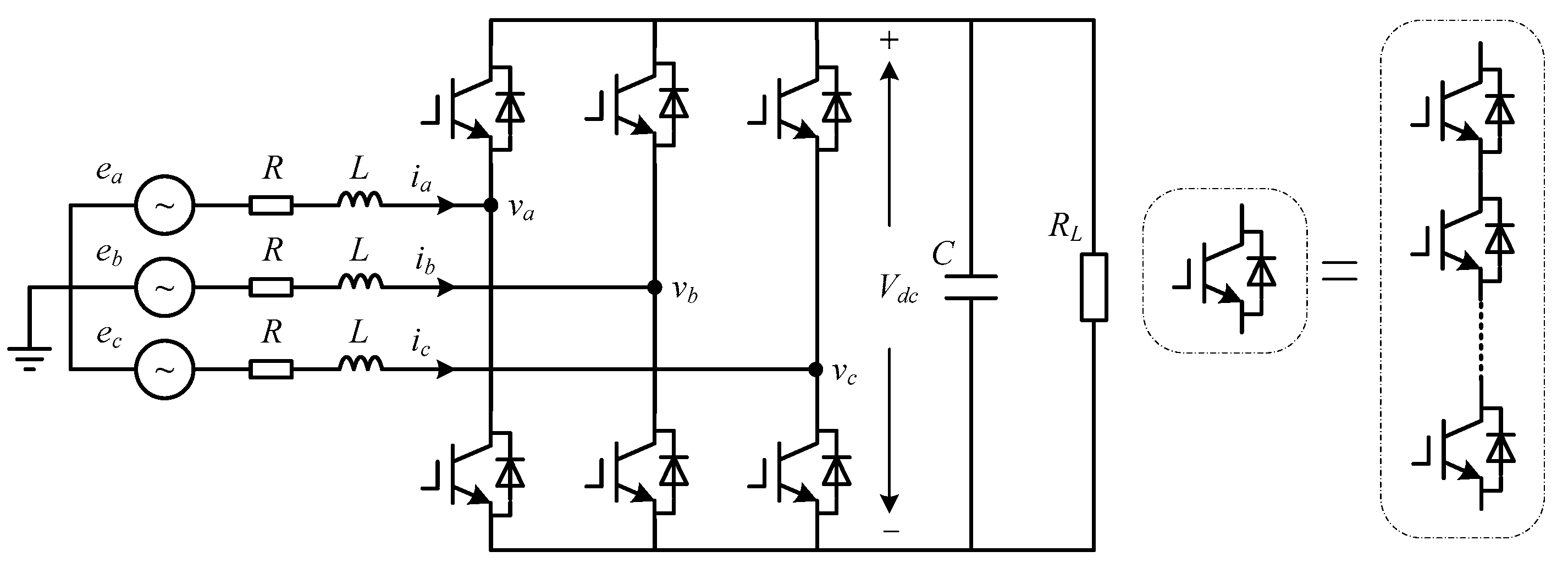
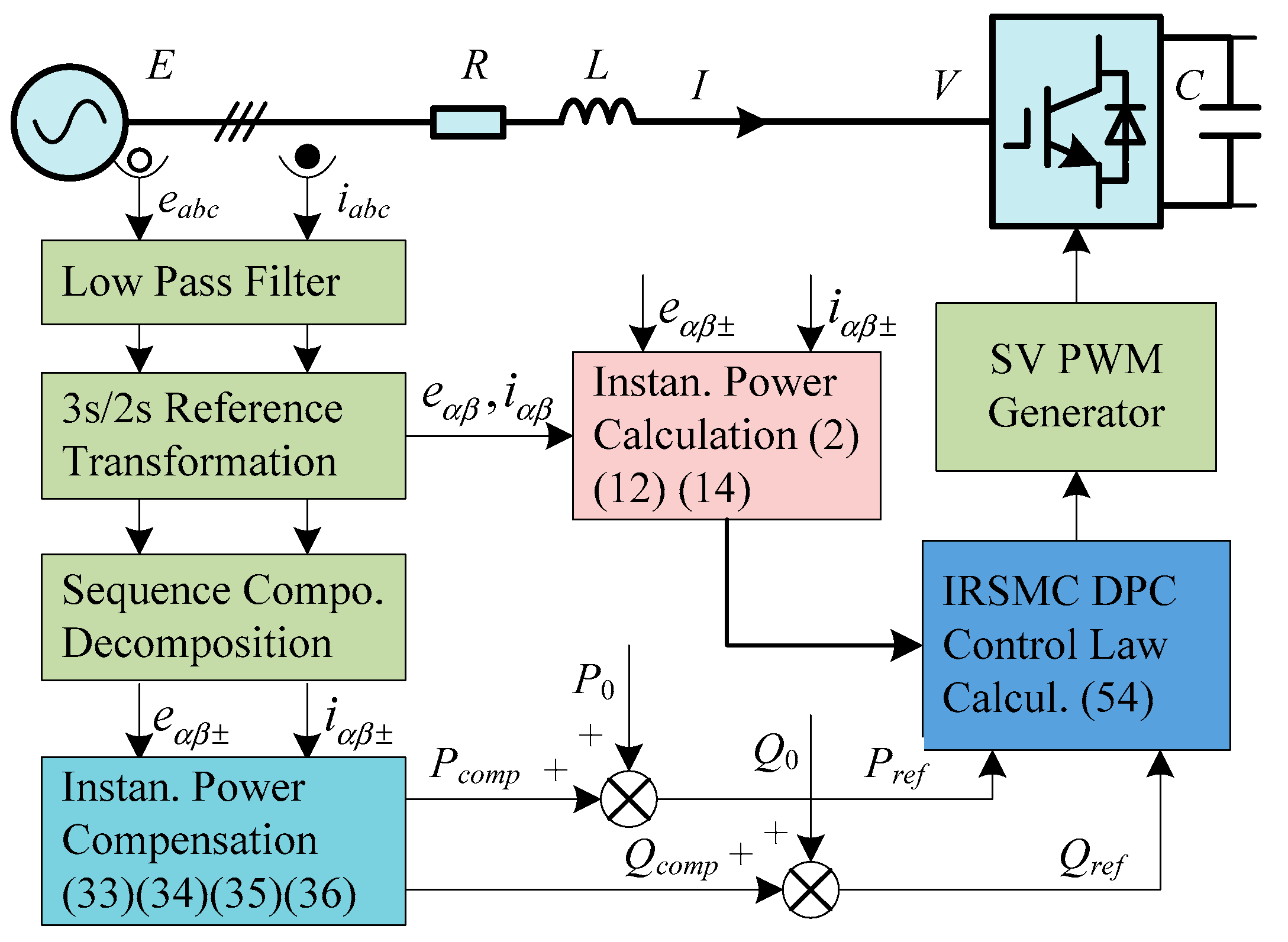
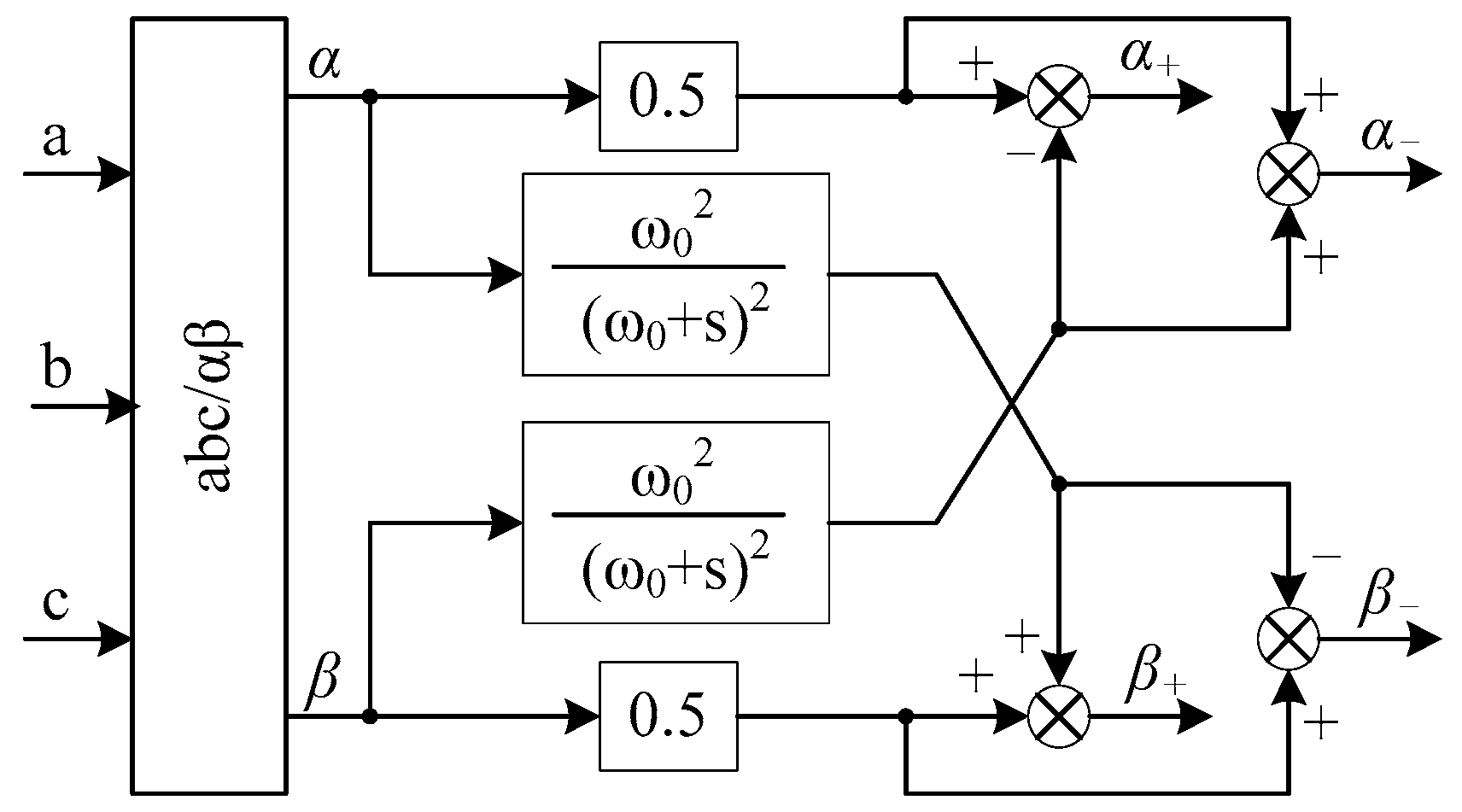
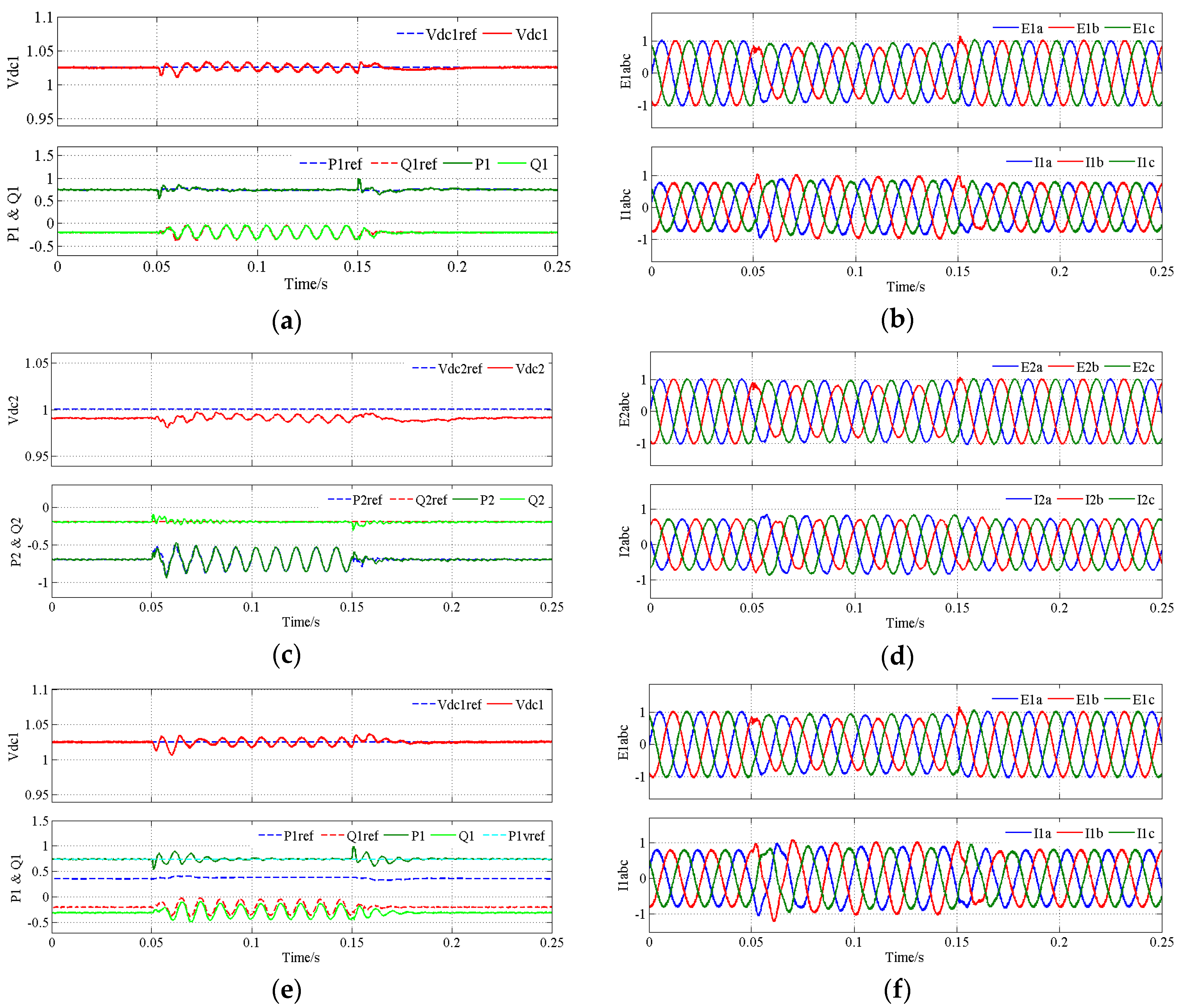
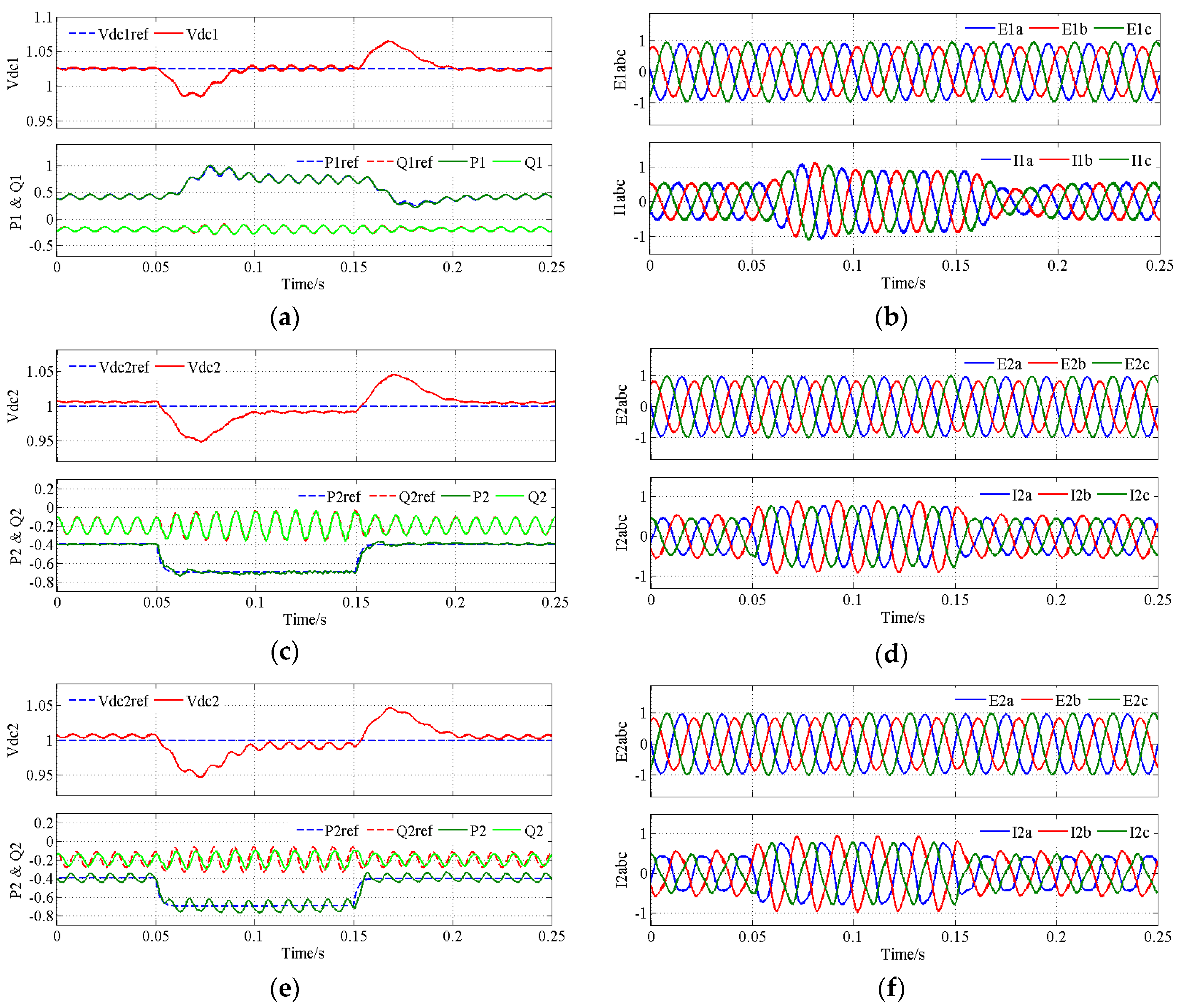
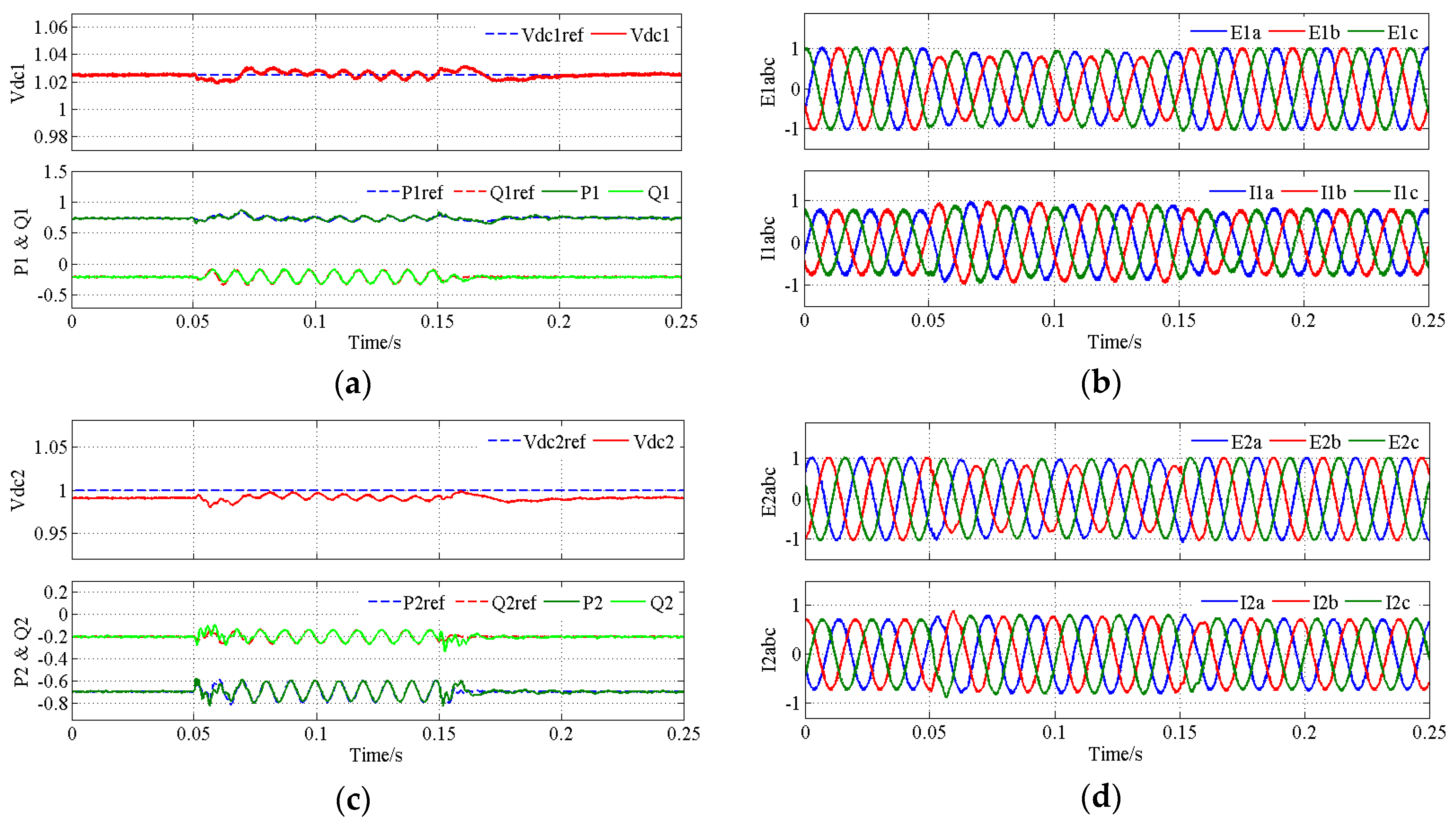
| Parameter | Value | Parameter | Value |
|---|---|---|---|
| KPI, KQI | 50 | KPR, KQR | 2.5 |
| KPS, KQS | 1200 | ωc | 10 |
| Symbol | Meaning |
|---|---|
| Vdc1, Vdc2 | Dc bus voltage on CS1 and CS2 side |
| E1abc, E2abc | Grid voltage on CS1 and CS2 side |
| I1abc, I2abc | Ac current on CS1 and CS2 side |
| P1, Q1, P2, Q2 | Active and reactive power at PCC of CS1 and CS2 |
| P1ref, Q1ref, P2ref, Q2ref | Active and reactive power references to respective power control loop for CS1 and CS2 |
© 2017 by the authors. Licensee MDPI, Basel, Switzerland. This article is an open access article distributed under the terms and conditions of the Creative Commons Attribution (CC BY) license (http://creativecommons.org/licenses/by/4.0/).
Share and Cite
Yang, W.; Zhang, A.; Li, J.; Li, G.; Zhang, H.; Wang, J. Integral Plus Resonant Sliding Mode Direct Power Control for VSC-HVDC Systems under Unbalanced Grid Voltage Conditions. Energies 2017, 10, 1528. https://doi.org/10.3390/en10101528
Yang W, Zhang A, Li J, Li G, Zhang H, Wang J. Integral Plus Resonant Sliding Mode Direct Power Control for VSC-HVDC Systems under Unbalanced Grid Voltage Conditions. Energies. 2017; 10(10):1528. https://doi.org/10.3390/en10101528
Chicago/Turabian StyleYang, Weipeng, Aimin Zhang, Jungang Li, Guoqi Li, Hang Zhang, and Jianhua Wang. 2017. "Integral Plus Resonant Sliding Mode Direct Power Control for VSC-HVDC Systems under Unbalanced Grid Voltage Conditions" Energies 10, no. 10: 1528. https://doi.org/10.3390/en10101528





